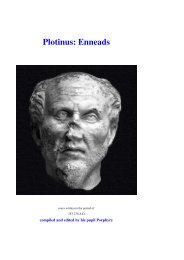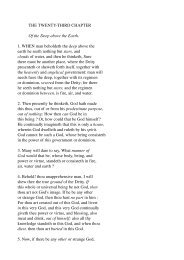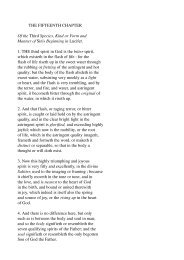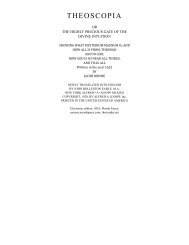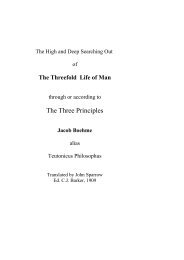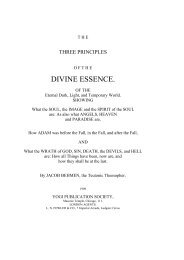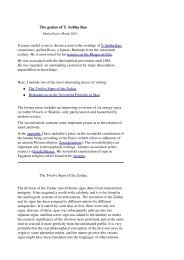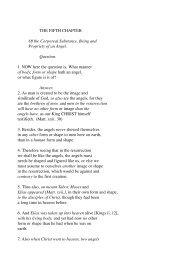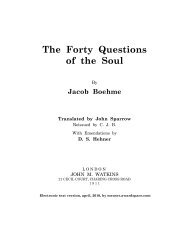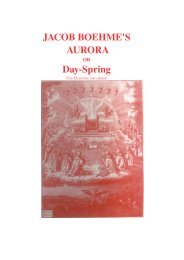Gerald Massey's Lectures - Society in evolution - Awardspace
Gerald Massey's Lectures - Society in evolution - Awardspace
Gerald Massey's Lectures - Society in evolution - Awardspace
Create successful ePaper yourself
Turn your PDF publications into a flip-book with our unique Google optimized e-Paper software.
typical of their be<strong>in</strong>g refleshed; and the bone, head, mask, or body so saved became the<br />
symbol of a salvation and a saviour, because it was an image of transformation. This was<br />
the mummy figure <strong>in</strong> Egypt. To "karas," <strong>in</strong> Egyptian, is to ano<strong>in</strong>t, embalm, or make the<br />
mummy; and the type of preservation so made was called the Karast or Christ. Such, I<br />
ma<strong>in</strong>ta<strong>in</strong>, is the Egyptian orig<strong>in</strong> of the Christ called the Ano<strong>in</strong>ted <strong>in</strong> Greek. The one who<br />
transformed and rose aga<strong>in</strong> from the dead, designated the Karast or Christ, was<br />
represented both by the prepared and preserved mummy, and by the carven image, which<br />
was the likeness of a dead man. Moreover, this was the orig<strong>in</strong>al Christ, whose vesture<br />
was without seam. In mak<strong>in</strong>g the perfect mummy type of cont<strong>in</strong>uity or immortality the<br />
body had to be bound up <strong>in</strong> the ketu or woof, a seamless robe, or a bandage without a<br />
seam. No matter how long this might be--and some swathes have been unrolled that were<br />
1000 yards <strong>in</strong> length--it was woven without a seam. This, I repeat, was the seamless robe<br />
of the mystical Christ, which re-appears as the coat, coat<strong>in</strong>g, or chiton (cf. ketu, Eg.<br />
woof) of the Christ accord<strong>in</strong>g to John. The Assyrians also made use of a mysterious<br />
sacred image called the mamit, or mamitu. It is celebrated <strong>in</strong> their hymns as the Mamit!<br />
the Mamit! the Treasure which passeth not away! It is spoken of as a shape of salvation,<br />
descend<strong>in</strong>g from the midst of the heavenly abyss: a life-giv<strong>in</strong>g image that was placed, as<br />
is the Cross, <strong>in</strong> the hands of the dy<strong>in</strong>g, to drive away evil spirits. This mamit was the sign,<br />
or fetish-image, of the one deity who never fails. I have shown elsewhere that this type of<br />
eternal life was identical with the Corpus Dom<strong>in</strong>i, the mummy-krist of Egypt! The Bit-<br />
Mamiti was the house of the mummies! The Kan-Mamiti was the book of the mummy;<br />
and the Mamit I hold to have been the image of the resurrection; a type and teacher of the<br />
Eternal! So, Mammoth <strong>in</strong> Hebrew is a name of the corpse as the image of the dead.<br />
We can trace the Karast or Mummy-Christ of Egypt a little further. When he transformed<br />
<strong>in</strong> the underworld, spiritualised or obta<strong>in</strong>ed a soul <strong>in</strong> the stars of heaven, he rose on the<br />
horizon as or <strong>in</strong> the constellation Orion--that is, the star of Horus, the Karast, or Christ.<br />
Hence Orion is named the Sahu, or constellation of the mummy who has transformed and<br />
ascended <strong>in</strong>to heaven from the Mount of the Equ<strong>in</strong>ox, at the end of forty days, as the<br />
starry image of life to come, the typical Saviour of men. And Orion must have<br />
represented the risen Horus, the karast or Christ, at least 6000 years ago! This Christ is<br />
said to come forth sound, with no limb miss<strong>in</strong>g and not a bone broken, because the<br />
deceased was reconstituted <strong>in</strong> accordance with the physical imagery. And by aid of this<br />
Corporeal Christ of Egypt we can understand why the risen Christ of the Gospels is made<br />
to demonstrate that he is not a spirit or bodiless ghost, as the disciples thought, but is <strong>in</strong><br />
possession of the flesh and bones of the properly preserved corpse. They have omitted the<br />
transformation <strong>in</strong>to the spiritual Christ. Thus <strong>in</strong> that character he is only the corpus<br />
Christi, or mummy-Christ, of Egypt--a type transferred and not a reality, either spiritual<br />
or physical. There can be no doubt of this, for the child-Christ (copied <strong>in</strong>to my book) is<br />
actually portrayed on a Christian monument <strong>in</strong> the Roman catacombs as this very image<br />
of the Mummy-Christ of Egypt, bound up <strong>in</strong> the seamless swathe of the Karast.<br />
Some of the Christian Fathers supposed that the Egyptians believed <strong>in</strong> the physical<br />
resurrection of the preserved body, and this false <strong>in</strong>ference is frequently echoed <strong>in</strong> our<br />
own day. But it is a mistake of the ignorant. The doctr<strong>in</strong>e of the resurrection of the Body<br />
is not Egyptian. There is proof extant that the Egyptians did not make the Mummy as<br />
their type of a physical resurrection. Be<strong>in</strong>g phenomenal and not mere theoretical<br />
Spiritualists, they had no need of a Corporeal resurrection. With them the deathless only<br />
was div<strong>in</strong>e, and their dead are spirits div<strong>in</strong>ized by rebirth <strong>in</strong> the likeness of their Gods. I<br />
repeat, the doctr<strong>in</strong>e of the physical resurrection of the body is not Egyptian. We f<strong>in</strong>d <strong>in</strong><br />
the "Book of the Dead" that the promise of all blessedness, the supreme felicity, is for the<br />
spirit not to re-enter the earthly body for evermore. In the rubric to chapter lxxxix. we<br />
read--"His soul does not enter, or is not thrust back, <strong>in</strong>to his mummy forever." Their idea<br />
of the life hereafter always turned on the transformation, and not on the resurrection, of



